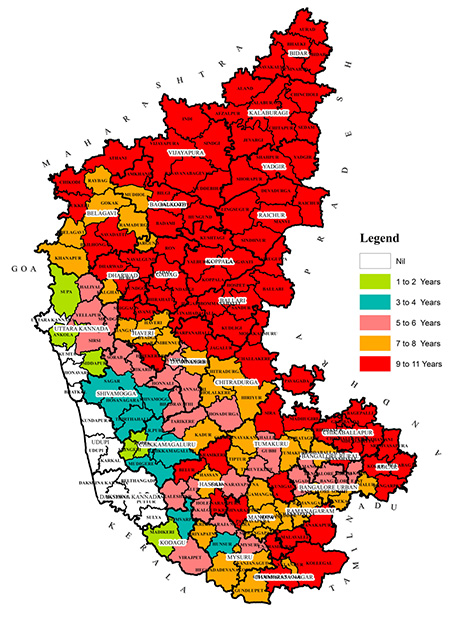
Increased farmer suicides may dampen BJP's chances in Karnataka

It’s been three years since the National Crime Records Bureau released statistics on farmer suicides, even as the situation in Karnataka, which has seen recurring droughts, continues to get worse. The state registered the second highest farmer suicide rate in the country. In 2014, about 768 farmers and farm labourers committed suicide in Karnataka. It doubled to 1,569 suicides in 2015.
Karnataka witnessed severe and protracted drought for three consecutive years since 2015. And it recorded 12 droughts in 15 years till 2015. Most of North Karnataka, barring a few taluks in Belagavi and Haveri, and the districts surrounding Bangalore Urban, are the worst affected, witnessing over nine droughts in 15 years.

“Despite receiving good rainfall, it is unfortunate that we witnessed drought this year. Though the rainfall was normal, the rain days were less in many parts of the state. And it failed during the key sowing season. This resulted in heavy crop losses,” said Karnataka State Natural Disaster Monitoring Centre (KSNDMC) director Srinivasa Reddy. “Depending on the rainfall pattern, we advised farmers to change the crop pattern. But it takes time to convince them to accept the change.”
The state government declared 156 of the 176 taluks as drought-hit. Though Karnataka witnessed just 4% deficit rains (considered normal) during the kharif season (between June and September), the intermittent rainfall resulted in severe drought. North Karnataka witnessed 37% deficit rainfall during kharif season. During rabi season (October to December), the state witnessed 49% deficit rainfall.
Crops worth ₹28,046 crore, covering 2.7 million hectares of kharif crops and 2.04 million hectares of rabi crops, are drought hit, according to the state agriculture department. Maize, tur, Bengal gram, groundnut and jowar are the worst-affected crops.
Mallappa Naikod, a farmer in Siddapura panchayat in Kalaburgi district, said he got only four quintals of tur instead of the six he expected in his 2.75 acres of land due to less rain this year. “I incurred a loss of ₹22,000, apart from selling the existing tur at a lower price due to its poor quality,” he added.
The agri commissioner expect a 25% drop in food production for the just-concluded financial year. “The food production for the year 2017-18 was estimated at 141.72 lakh tonnes. But for the present year (2018-19) we expect it to around 106.63 lakh tonnes,” department officials said in an email response to The Federal.
Politics over drought
For political parties, drought is good meat for their election campaigns. The ruling JD(S)-Congress coalition blames the central government, led by Prime Minister Narendra Modi, for its poor policies, including the flawed import-export policies, crop insurance schemes, demonetisation, and failure to meet the promise of doubling farmers’ income. But the BJP takes on the state for poor implementation of the central schemes.
The BJP rode to power with a promise to double farmer incomes, increase minimum support prices by 1.5 times the cost of production, rationalise agricultural markets, make institutions for procurement more efficient, and promote value additions to food production. Apart from ensuring increased farm income, the BJP promised a minimum of 50% profit over cost of production in its 2014 election manifesto. But the Indian Express reported that in the October to December 2018 quarter, the farm income growth was at its lowest in 14 years.
The number of households seeking jobs under the Mahatma Gandhi National Rural Employment Guarantee Act increased by 70% in the past four years. It rose from 12.36 lakh in 2015-16 to 21.11 lakhs in 2018-19.
“The Pradhan Mantri Fasal Bima Yojana, the government-sponsored crop insurance scheme, is an utter failure. Poor credit planning and inflation led to rise in production cost. And private companies looted our farmers,” alledged Eshwar Khandre, the Karnataka Pradesh Congress Committee working president and Bidar MP contestant. “In Bidar district, about 1.80 lakh farmers enrolled last year and paid ₹14.6 crore as insurance premium, and both the centre and state government together contributed ₹186 crore. But the farmers got barely 0.45% as claims. Private insurance companies swindled the rest,” he added.
The Karnataka government submitted a memorandum to the Centre seeking ₹2,434 crore for kharif crop loss and ₹2,064 crore for rabi crops under the National Disaster Response Force for drought relief measures. So far, the Centre has allocated about ₹949 crore as drought relief and released only half of it.
Meanwhile, the BJP state leadership questioned the state government’s failure in terms of farm loan waivers, with most farmers yet to receive the benefit. It also questioned the state on what action is has taken against sugar companies that have delayed payments to farmers. The Federal report indicates that several companies in the state owe farmers about ₹3,300 crore — about 30% of the overall payment — for the cane crushed during 2018-2019.
Drinking water crisis
Reservoirs in the Cauvery catchment are a third as full as they should be. Also, about 40% of 3,611 minor irrigation tanks are dry statewide, and about 47% of them have water capacity less between 30-50%. In all, 892 villages face drinking water crisis, and the state government stepped in to supply water through tankers in most of the drought-hit districts. In Bidar alone, the government supplies 1451 tankers of water every day.
In its response to a question in the Lok Sabha on the delays in publishing the farmer suicide report, the home ministry in December said that the finalisation of the report will take some more time (without specifying by when will it release it). It did, however, list everything that the government has done for farmers so far. But things only seem to have gotten worse for farmers.


